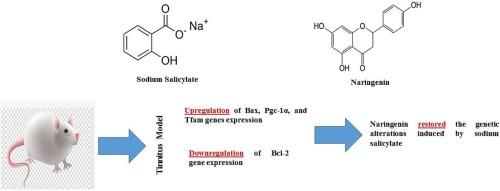通过检测 Bax、Bcl-2、Tfam 和 Pgc-1α 等基因指标,探讨柚皮素对慢性耳鸣雄性 Wistar 大鼠海马细胞功能和能量合成的影响。
IF 2.6
3区 生物学
Q2 GENETICS & HEREDITY
引用次数: 0
摘要
背景:神经可塑性、氧化应激、神经元炎症和细胞凋亡等关键因素在耳鸣的发病机制中起着重要作用。Bax/Bcl-2 基因之间的平衡是决定细胞凋亡速度的重要因素。Pgc-1α 和 Tfam 基因是线粒体生物生成的基本调节因子。柚皮苷具有显著的抗氧化、神经保护、抗炎、抗凋亡和抗病毒等作用,其化合物对细胞信号通路有效。目的:根据上述信息,我们试图评估柚皮苷对慢性耳鸣雄性Wistar大鼠海马中Bcl-2、Bax、Pgc-1α和Tfam基因表达水平的影响:为了证明耳鸣的存在,所有大鼠都被要求利用条件盒完成 "主动回避测试"。使用实时 PCR 评估上述基因的表达水平:结果:剂量为 350 毫克/千克的水杨酸钠会上调 Bax 基因的表达水平,下调 Bcl-2 基因的表达水平:我们的研究结果表明,水杨酸钠诱导的耳鸣会导致海马内细胞凋亡和线粒体生物生成增强。此外,我们的证据还表明,柚皮素能有效减少细胞凋亡,维持线粒体的平衡状态。本文章由计算机程序翻译,如有差异,请以英文原文为准。

Exploring the effects of naringenin on cell functioning and energy synthesis in the hippocampus of male Wistar rats with chronic tinnitus, by examining genetic indicators such as Bax, Bcl-2, Tfam, and Pgc-1α
Background
The pivotal factors, including neural plasticity, oxidative stress, neuronal inflammation, and apoptosis, play a significant role in the pathogenesis of tinnitus. The balance between Bax/Bcl-2 genes is an important factor in determining the rate of apoptosis. Pgc-1α and Tfam genes are fundamental regulators of mitochondrial biogenesis. Naringenin possesses significant antioxidant, neuroprotective, anti-inflammatory, anti-apoptotic, and antiviral properties, and its compounds are effective on cell signaling pathways.
Aims
In light of the aforementioned information, we endeavored to evaluate the impact of naringenin on the expression levels of Bax, Bcl-2, Pgc-1α, and Tfam genes in the hippocampus of male Wistar rats with chronic tinnitus.
Material and Methods
To demonstrate the existence of tinnitus, all rats were instructed to complete an “active avoidance test” utilizing a conditioning box. The expression levels of genes mentioned above were assessed using real-time PCR.
Results
The sodium salicylate at a dosage of 350 mg/kg showed an upregulation in the expression level of Bax and a downregulation in the expression level of the Bcl-2 gene (p < 0.001). Furthermore, the sodium salicylate displayed significantly higher expression levels of Tfam and Pgc-1α (p < 0.001) genes. The naringenin, at a dose of 100 mg/kg, led to a decrease in Bax gene expression (p < 0.05) and an increase in Bcl-2 gene expression (p < 0.05). On the other hand, naringenin restored the expression level of both Tfam (p < 0.001) and Pgc-1α (p < 0.01) genes.
Conclusions
Our research findings demonstrate that sodium salicylate-induced tinnitus leads to enhanced apoptosis and mitochondrial biogenesis within the hippocampus. Additionally, our evidence recommends that naringenin can reduce apoptosis effectively and maintain a balanced mitochondrial state.
求助全文
通过发布文献求助,成功后即可免费获取论文全文。
去求助
来源期刊

Gene
生物-遗传学
CiteScore
6.10
自引率
2.90%
发文量
718
审稿时长
42 days
期刊介绍:
Gene publishes papers that focus on the regulation, expression, function and evolution of genes in all biological contexts, including all prokaryotic and eukaryotic organisms, as well as viruses.
 求助内容:
求助内容: 应助结果提醒方式:
应助结果提醒方式:


